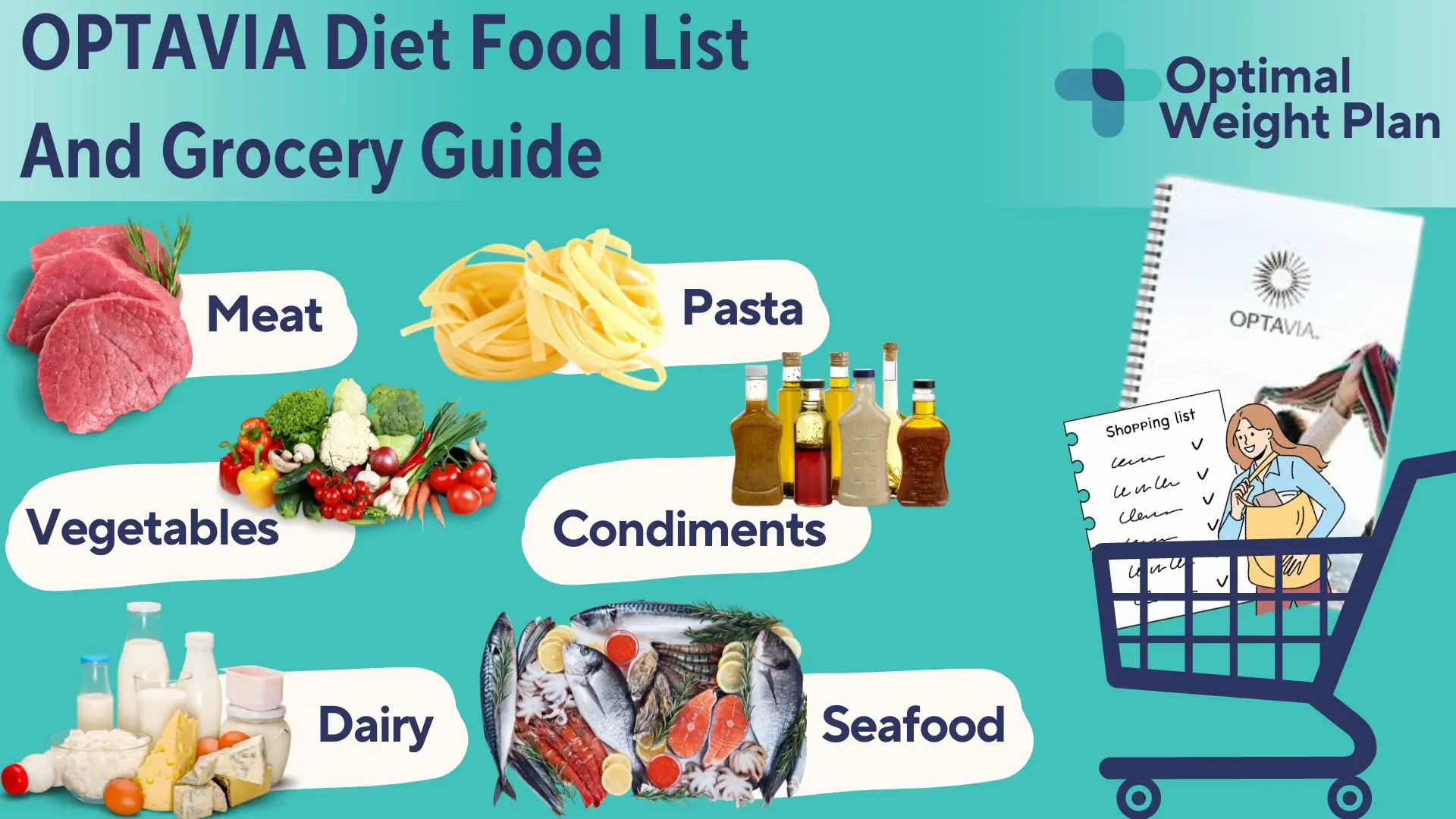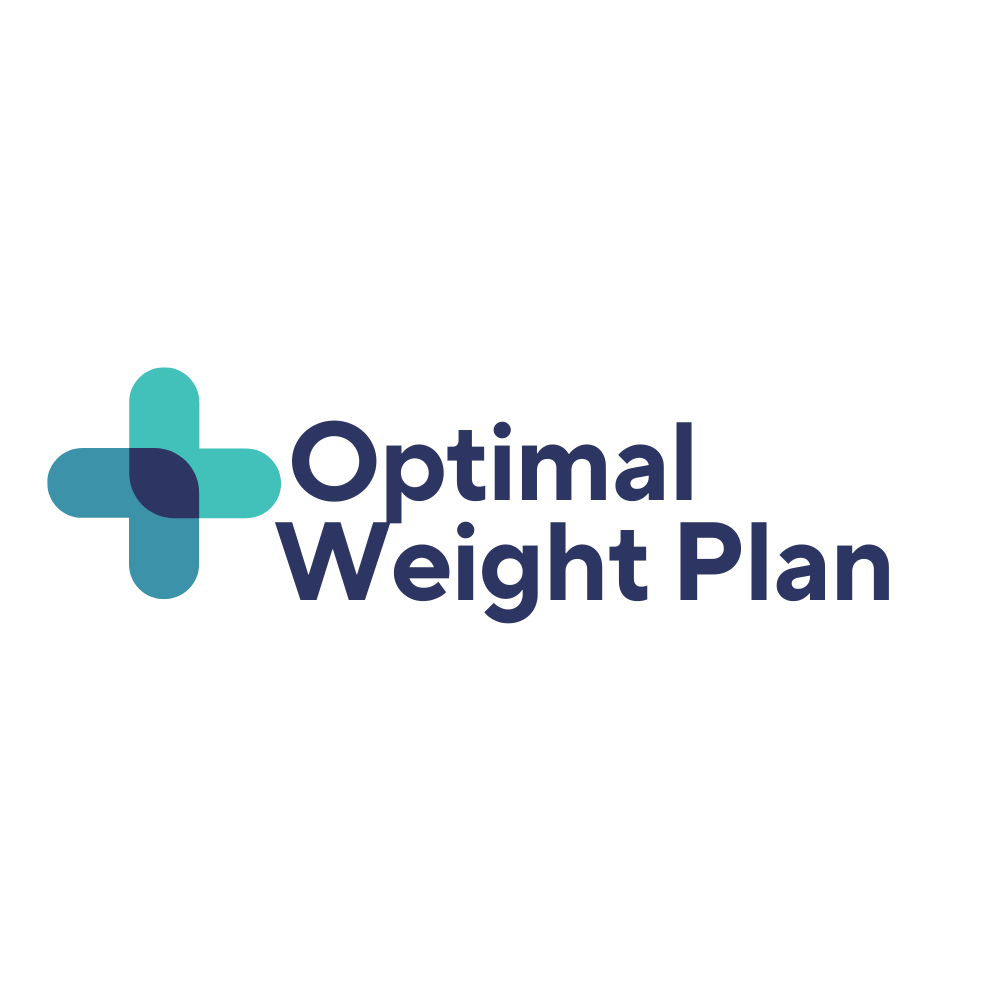The OPTAVIA diet food list is important for following the OPTAVIA 5 & 1 plan and making lean and green meals. It includes OPTAVIA Fuelings, low-carbohydrate vegetables, lean proteins, low-fat dairy products, certain condiments, and healthy fats. There are options for meatless meals and frozen foods. What’s not allowed? High-carb vegetables, grains, fruits, beans, sugary sweets, and alcohol are excluded to follow the diet’s guidelines.
We know the OPTAVIA 5 & 1 plan can be strict. That’s why having a clear OPTAVIA food list is key for long-term success and weight loss. It will help you control portions and keep your meals balanced. Need extra help? An OPTAVIA coach can motivate you, answer your food questions, and help you navigate the diet’s complexities. While the following list of OPTAVIA diet foods is a great starting point, reach out to one of our OPTAVIA coaches at Optimal Weight Plan for personalized meal plans, food lists, and ongoing support!
1. OPTAVIA Fuelings
OPTAVIA Fuelings are branded meal replacements (like cereals, drinks, bars, etc.) that form the foundation of the OPTAVIA diet food list. The ‘5’ in the 5 & 1 plan refers to eating five Fuelings per day instead of regular meals, though the exact number may vary depending on your specific program. Each OPTAVIA Fueling contains a consistent balance of macronutrients like carbohydrates, fats, and protein for easy portion control.
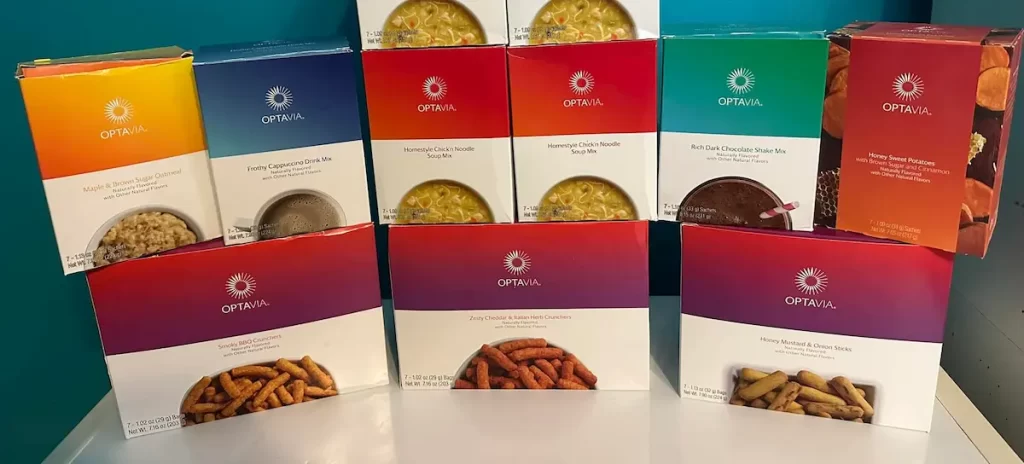
But what are they made of? While all Fuelings offer similar calories, vitamins, and minerals, the specific ingredients vary. Bars often rely on soy and milk protein isolates, while savory options like Roasted Garlic Mashed Potatoes or Cheesy Buttermilk Cheddar Mac use milk protein concentrate and whey protein isolate. Does OPTAVIA use artificial sweeteners? No, they primarily use natural options like monk fruit extract.
2. Lean Meats
One of the main parts of the OPTAVIA food list is lean meats, an essential part of the lean and green meals. The OPTAVIA meat list refers to the selection of approved animal proteins that can be included in the 5 and 1 plan. But does this mean I can eat any type of meats on OPTAVIA, including salami, burgers, and sausages? No. While processed meats like these are fine in moderation, they are high in calories, saturated fats, and sodium – all of which are restricted during the 5 & 1 weight loss phase.
So what types of meats are included in the OPTAVIA diet food list? For your Lean and green meals can include protein options like 5-7 oz of cooked lean meats, such as chicken, turkey, beef, and pork, as well as selected meatless vegetarian options. This table shows the types of meat list you can include in your OPTAVIA diet food list.
| Meat Type | Calories | Protein (g) | Fat (g) | Serving Size |
|---|---|---|---|---|
| Turkey breast | 54 | 8.2 | 0.1 | 6 oz (leaner) |
| Turkey wing | 56 | 9.0 | 3.49 | 6 oz (leaner) |
| Chicken breast | 40 | 8.0 | 1.0 | 6 oz (leaner) |
| Chicken wing | 92 | 8.0 | 6.0 | 5 oz (lean) |
| Chicken drumsticks | 48 | 7.8 | 1.9 | 6 oz (leaner) |
| Chicken thigh | 54 | 6.8 | 3.3 | 6 oz (leaner) |
| Chicken leg | 52 | 7.0 | 2.5 | 6 oz (leaner) |
| Whole duck | 880 | 102 | 48 | 5 oz (lean) |
| Duck breast | 63 | 7.3 | 3.1 | 5 oz (lean) |
| Duck wings | 80 | 9.3 | 4.4 | 5 oz (lean) |
| Duck drumstick | 150 | 17.6 | 8.4 | 5 oz (lean) |
| Beef chuck | 62 | 7.7 | 3.29 | 6 oz (leaner) |
| Beef rib | 87 | 4.7 | 7.5 | 5 oz (lean) |
| Beef brisket | 53 | 6.8 | 12.65 | 6 oz (leaner) |
| Beef sirloin | 64 | 8.4 | 3.3 | 6 oz (leaner) |
| Beef tenderloin | 58 | 8.67 | 2.46 | 6 oz (leaner) |
| Beef flank | 72 | 8.7 | 2.35 | 5 oz (lean) |
| Beef round | 49 | 9.0 | 1.2 | 6 oz (leaner) |
| Pork shoulder | 76 | 5.3 | 2.35 | 5 oz (lean) |
| Pork chop | 51 | 8.4 | 1.87 | 6 oz (leaner) |
| Pork steak | 73 | 8.2 | 3.7 | 5 oz (lean) |
| Pork tenderloin | 40 | 7.45 | 1.16 | 6 oz (leaner) |
| Pork ribs | 88 | 5.6 | 5.28 | 5 oz (lean) |
| Pork loin | 43 | 6.02 | 1.87 | 6 oz (leaner) |
| Pork spareribs | 79 | 7.2 | 7.09 | 5 oz (lean) |
| Pork bacon | 158 | 7.48 | 13.87 | 5 oz (lean) |
Can you also eat other meats that aren’t on the list, such as ham, meatballs, or steak on OPTAVIA? Yes, you can, but the serving size varies depending on the leanness of the protein source, with 7 oz serving for the leanest cuts of meat, while 5 oz for the fattiest cuts.
3. Fish and Seafood
Fish and seafood are another excellent choice for your lean protein on the OPTAVIA 5 & 1 plan. OPTAVIA offers over 30 fish recipes to help you enjoy a variety of options. Here are some types of fish and seafood allowed on the OPTAVIA food and grocery list:
- Cod
- Flounder
- Haddock
- Tuna
- Swordfish
- Trout
- Halibut
- Salmon
- Mackerel
- Herring
Remember, serving sizes vary depending on the fat content:
- Leanest fish (7oz): cod, flounder, haddock, tuna, tilapia, and wild catfish.
- Moderate fat fish (6oz): swordfish, trout, and halibut.
- Highest fat fish (5oz): salmon, mackerel, and herring.
4. Eggs
Eggs are one of the best high-protein diet foods on OPTAVIA (and a great meatless option) for your Lean & Green meals. At Optimal Weight Plan, we also love them as fuelings substitutes and DIY snacks! But can you eat eggs every day on OPTAVIA? No, moderation is important. Serving size and the form of eggs will dictate your intake. For example, if using egg whites, one ‘leanest’ serving equals 14 egg whites or 2 cups of liquid egg substitute. However, if using whole eggs, you can have up to 3 (no more than twice a week).
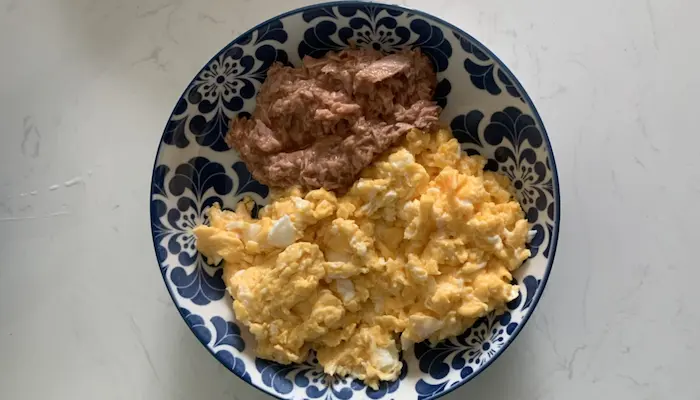
Why the difference? A study in the European Journal of Nutrition suggests “eating just 2-4 eggs per week was associated with increased risk of all-cause and CVD mortality.” So, enjoy eggs on Optavia, but try separating whites from yolks for at least half of them.
5. Low Fat or Fat-Free Dairy
Dairy products are an important part of the OPTAVIA food list, specifically low-fat or fat-free options because they contain fewer calories and less fat than full-fat dairy products. They’re also a great choice when building your meatless OPTAVIA food list. So, what type of dairy is allowed? Two popular options are cottage cheese (12 oz), which boasts about 37 grams of protein, and plain Greek yogurt (12 oz), which has around 9.5 grams. These are ideal due to their low fat content and high protein. Here are other types of dairy products you can add to your OPTAVIA shopping list.
- Cottage cheese
- Plain Greek yogurt
- Ricotta cheese
- Mozzarella cheese
Keep in mind that while there are many kinds of cheese allowed on the 5 and 1 plan, most of them should be consumed only in small servings as condiments due to their higher calorie content. For example, you can eat cheddar cheese, feta cheese, or string cheese, but these won’t be counted as proteins.
6. Plant-based Proteins
OPTAVIA also offers plant-based protein options for vegetarians and vegans. Approved sources include tempeh (5 oz), tofu (15 oz), or seitan (5 oz). However, it’s important to note that not all plant-based proteins are allowed on OPTAVIA. Legumes like peas, chickpeas, and lentils are excluded due to their high carbohydrate content.
How do meatless options compare to animal-based protein? A 2020 study by Steven R. Hertzler suggests that most animal-based proteins generally have a higher protein quality score (PDCAAS) than plant-based options, ash shown in this table.
| Protein | PDCAAS 1 | DIAAS 3 | Lowest Amino Acids |
|---|---|---|---|
| Milk | 1.00 | 1.08 | None |
| Whey | 1.00 | 0.90 | Histidine |
| Soy | 0.99 | 0.92 | Sulfur Amino Acids (methionine and cysteine) |
| Canola | 0.88 | NA | Aromatic Amino Acids (phenylalanine and tyrosine) |
| Potato | 0.87 | 0.85 | Histidine |
| Pea | 0.83 | 0.66 | Sulfur Amino Acids (methionine and cysteine), Tryptophan |
| Quinoa | 0.78 | NA | Isoleucine, Leucine, Lysine, Threonine, Valine |
| Chickpea | 0.77 | 0.69 | Leucine, Lysine, Sulfur Amino Acids (methionine and cysteine), Threonine, Tryptophan, Valine |
| Lentils | 0.73 | 0.75 | Leucine, Sulfur Amino Acids (methionine and cysteine), Threonine, Tryptophan, Valine |
| Red Kidney beans | 0.68 | 0.61 | Leucine, Lysine, Sulfur Amino Acids (methionine and cysteine), Aromatic Amino Acids (phenylalanine and tyrosine), Threonine, Tryptophan, Valine |
| Fava/faba | 0.63 | NA | Lysine, Sulfur Amino Acids (methionine and cysteine), Threonine, Tryptophan, Valine |
| Barley | 0.63 | 0.50 | Lysine |
| Pinto beans | 0.61 | NA | Histidine, Isoleucine, Leucine, Lysine, Sulfur Amino Acids (methionine and cysteine), Aromatic Amino Acids (phenylalanine and tyrosine), Threonine, Tryptophan, Valine |
| Rice | 0.53 | 0.52 | Lysine, Threonine |
| Oat | 0.51 | 0.44 | Lysine, Threonine |
| Peanut | 0.46 | 0.47 | Isoleucine, Leucine, Lysine, Sulfur Amino Acids (methionine and cysteine), Threonine, Tryptophan, Valine |
| Wheat | 0.45 | 0.39 | Isoleucine, Leucine, Lysine, Aromatic Amino Acids (phenylalanine and tyrosine), Threonine, Valine |
| Corn | 0.41 | 0.38 | Isoleucine, Lysine, Sulfur Amino Acids (methionine and cysteine), Threonine, Tryptophan, Valine |
Based on our experience working with vegan and vegetarian OPTAVIA clients, we recommend combining a variety of plant-based protein sources in your Lean & Green meals to ensure a complete protein profile. Another important part of OPTAVIA approved foods are greens.
7. Low Carb Vegetables
Low-carb vegetables, also known as the OPTAVIA green list, are an essential part of your Lean & Green meals. You can have 3 servings of vegetables per meal. Serving sizes depend on the carbohydrate content and glycemic index of the food item, as shown in the list below.
Low carb vegetables, also referred to as OPTAVIA green list, is an essential part of your lean and green meals, which you can have 3 servings of vegetables per meal .The serving size of vegetables depends on the number of carbs and glycemic index of the food item, as show in the table below.
| Vegetable | Carb Level | Serving Size |
|---|---|---|
| Collards (fresh/raw) | Lower | 1 cup |
| Endive | Lower | 1 cup |
| Lettuce (green leaf, butterhead, iceberg, romaine) | Lower | 1 cup |
| Mustard greens | Lower | 1 cup |
| Spinach (fresh/raw) | Lower | 1 cup |
| Spring mix | Lower | 1 cup |
| Watercress | Lower | 1 cup |
| Bok choy (raw) | Lower | 1 cup |
| Celery | Medium/High | 1/2 cup |
| Cucumbers | Medium/High | 1/2 cup |
| Spaghetti squash | Medium/High | 1/2 cup |
| Hearts of palm | Medium/High | 1/2 cup |
| Swiss chard (cooked) | Medium/High | 1/2 cup |
Here are other vegetables you can include in your Lean & Green meals. Note: The serving size for all of these is 1/2 cup.

- Radishes
- Sprouts (alfalfa, mung bean)
- Turnip greens
- Arugula
- Nopales
- Escarole
- Jalapeño (raw)
- Broccoli
- Red cabbage
- Chayote squash
- Kabocha squash
- Summer squash
Are there any vegetables that are not allowed on OPTAVIA? Yes, some high-carb vegetables such as corn, carrots, potatoes, or sweet potatoes are not permitted during the OPTAVIA 5 & 1 Plan. They are allowed only during the transition and maintenance phases. Can you include them in the OPTAVIA diet food list? Yes, generally, you can include tomatoes in an OPTAVIA 5 & 1 Plan, but just be mindful of the portion size.
8. Healthy Fats
Healthy fats are the third component of your Lean & Green meals and should be an important part of your OPTAVIA grocery list. Each day, you can have up to 2 servings of healthy fats in your Lean & Green meals, but the exact amount will depend on your protein choices.
What types of fats are considered healthy by OPTAVIA? OPTAVIA recommends focusing on monounsaturated and polyunsaturated fats, as these are healthier than saturated fats. This aligns with recommendations from the American Heart Association to choose liquid non-tropical plant oils, low-fat or nonfat dairy, and lean meats or poultry (if you consume them). A 2021 study by Lukas Schwingshackl from the University of Freiburg, published in the Annals of Nutrition and Metabolism Journal, further supports the benefits of replacing saturated fats with healthier alternatives. The following list shows examples of healthy fats and their recommended serving sizes for your OPTAVIA food list.
- Avocado: 1 ½ oz
- Olives: 10 pieces
- Dark chocolate: 2 pieces
- Olive oil: 1 tbsp
- Almonds: 1⁄3 oz (8 pieces)
- Cashews: 1⁄3 oz (8 pieces)
- Peanuts: 1⁄3 oz (12 pieces)
- Pesto: 1 tbsp
- Mayonnaise (light): 1 ½ tbsp
- Walnuts: 1⁄3 oz (5 halves)
- Pumpkin seeds: 2 tbsp
- Sunflower seeds (kernel only): 1 tbsp
- Coconut (shredded, unsweetened): 1 ½ tbsp
- Cream cheese (regular): 1 tbsp
- Sour cream: 2 tbsp
What types of fats should you avoid on the OPTAVIA diet? Fats and condiments that didn’t meet the requirements for ‘healthy fats’ in the Optimal Weight 5 & 1 plan include: regular butter, peanut butter, honey, trans fats, lard, and solid shortening.
9. Condiments and seasonings
OPTAVIA condiments help to boost the taste and flavor, spiciness, sweetness, creaminess, and thickness of Lean and Green meals, without adding excess calories. One serving size of Optavia condiment contains a maximum of 30 calories (equivalent to approximately 125.52 kilojoules) and no more than 1 gram of carbohydrates.
Is it OK to include condiments and spices in the OPTAVIA food list? Yes. According to Optavia condiment guidelines, you can have up to 2 condiment servings per lean and green meal per day on all plans. A 2016 study published in the [Name of Journal] by Maria Nieves García-Casal, a licensed dietitian, nutritionist, and scientist from the World Health Organization (WHO), found that consuming condiments, particularly spices like curcumin, piperine, and capsaicin, has antioxidant, anti-inflammatory, and antitumorigenic benefits. So, which OPTAVIA-approved condiments are we talking about? Here is the list.
- Herbs
- Dried Herbs
- Sauces
- Syrups
- Milk and Milk Substitutes
- Baking and Cooking Ingredients
- Seeds
- Flavor Enhancers
Here you can find the PDF list of all the OPTAVIA condiments. This list is useful for anyone who needs a quick reference guide to the condiment.
10. Free Snacks
OPTAVIA free snacks are selected groups of foods and alcoholic beverages that can be consumed in moderation, and with specific serving sizes, during the Optimal Weight 4 & 2 and 1 Plan and the maintenance phase (once you’ve reached your weight loss goals). They are not part of the 5 & 1 Plan. The following list shows OPTAVIA free choice snacks.
- OPTAVIA Fuelings
- Hershey Kisses
- Muffin
- Low-fat ice cream
- Frosted cake
- Chocolate chip cookie
- Fat-free pudding
- Angel food cake
- Brownie
- Gingersnap cookie
- Dark chocolate
OPTAVIA free choice snacks work as an occasional treat to boost your motivation and make the process more sustainable. Choose only one of the many foods or beverages on the list, in addition to your Fuelings and lean and green meals. You can only have one Free Choice snack per day, at any time.
11. Sugar-Free Snacks
Sugar-free snacks like mints, gelatin, and chewing gum are allowed on the OPTAVIA 5 & 1 plan. Since they don’t contain sugar, they won’t directly hinder your weight loss efforts.
However, does chewing gum specifically help with weight loss on OPTAVIA? Research suggests it might not. A 2012 study by James M. Shikany and colleagues at the University of Alabama at Birmingham found no significant changes in weight or BMI between people chewing gum for at least 90 minutes daily and those who didn’t. Interestingly, waist circumference and blood pressure did decrease slightly within the gum-chewing group.
So, how much chewing gum is allowed on OPTAVIA? These types of sugar-free snacks are okay in moderation between OPTAVIA fuelings or after your lean and green meals. You can have up to 3 pieces of gum or mints per day.
What Types of Foods Are Approved on OPTAVIA?
The following list show what types of foods are approved on OPTAVIA 5 and 1 plan.
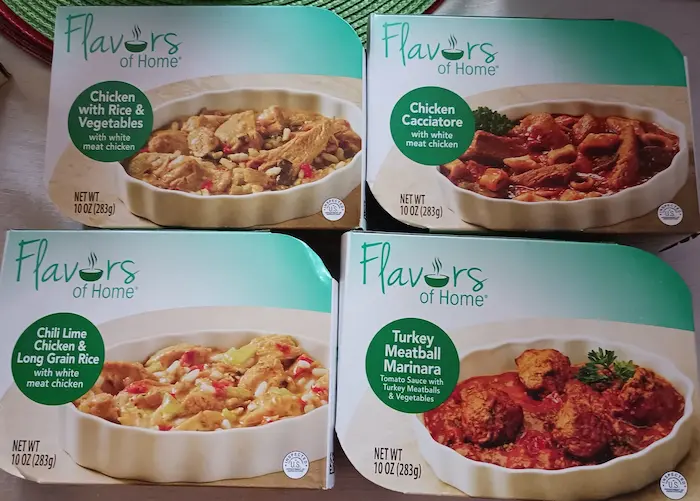
- Flavors of Home
- Frozen Meals
- Low Calorie Wraps
- Cereals Substitutes
- Yogurts
- Noodles
1. Flavors of Home
Flavors of Home are approved on OPTAVIA because each meal provides approximately 290 calories, 25 grams of protein, 14 grams of fat, 15 grams of carbohydrates, and 3 grams of dietary fiber – all within the Lean & Green guidelines. But what exactly are Flavors of Home? They’re pre-prepared, ready-to-eat meals ordered from the OPTAVIA website. These meals are a convenient option when you run out of food, don’t have time to grocery shop or cook, or simply need a healthier alternative to takeout.
2. Frozen Meals
Frozen meals are approved on OPTAVIA. Similarly to the Flavors of Home options, these are store-bought prepared meals that meet the macros of Lean & Green meals: typically under 400 calories, high in nutrients (over 25 grams of protein), and designed to promote weight loss and overall health. These are convenient substitutes for your own meals on occasion, especially during hectic periods when it’s difficult to adhere to the OPTAVIA-friendly food list, including time for grocery shopping, meal prep, and home cooking.
So, what are some OPTAVIA-approved frozen meal options on the 5 & 1 plan? These include Healthy Choice Grilled Chicken & Broccoli Alfredo (190 calories per serving, 28 grams of protein, just $3.42 per meal) or Lean Cuisine Steak Portabella (160 calories, 13 grams of carbs, and only $3.58 per meal).
3. Tortilla Wraps
Tortilla wraps are approved on OPTAVIA. According to Ryan, Optavia’s Dietetic Technician, “The type of wrap you choose determines whether it counts as one serving of lean, green, or condiment.” For example, egg white wraps are a great option for your LEAN serving due to their lower calories and higher protein content. Cauliflower wraps, as confirmed by OPTAVIA support, can be used as a green or a condiment.
OPTAVIA allows 2-3 wraps per day, as long as they have fewer than 30 calories and less than 1g of carbohydrates. If you choose a wrap as a condiment, remember that you’re limited to three condiments daily, so avoid adding others. We recommend Egglife Egg White Wraps, Crepini Egg Wraps, and Trader Joe’s Jicama Wraps as they are all low in calories, fat-free, and low in sodium.
4. Low Sugar Cereals
Low-sugar cereals are approved on OPTAVIA as substitutes for typical OPTAVIA Fuelings in the morning. Ideally, your OPTAVIA-friendly cereal choices should have nutritional values similar to Fuelings: at least 10 grams of protein, under 10 grams of carbohydrates, and no more than 100-130 calories per serving.
What cereal is comparable to OPTAVIA cereals? One option is Wholesome Provisions Protein Cereal. While they offer several flavors, the Cocoa Protein Cereal is a great choice with the fewest net carbs (4g), the most protein (15g per serving), and only 114 calories. Another good choice is BariWise Protein Diet Cereals, which have 15 grams of protein, 8 grams of carbs, and 120 calories per serving, costing $16.99 for 5 servings.
5. Low Fat Yogurts
Low-fat yogurts are approved on OPTAVIA. You can include them in your food list as a protein source or a Fueling alternative, as long as they contain no more than 100 calories and less than 10 grams of carbs. Consider Dannon Light & Fit Greek Yogurt, which offers more protein and fewer calories than many OPTAVIA bars and shakes. The 6-count packs cost around $5.58 ($0.93 per serving), making it three times less expensive than typical Essential Fuelings. Another option is Chobani Zero Sugar Greek Yogurt, boasting 60 calories, 0 grams of fat, 0 grams of sugar, and 11 grams of protein per 5.3 oz container. You can find all Zero Sugar flavors at Walmart for $1.38 each.
6. Low Carb Noodles
Low-carb noodles are approved on OPTAVIA, with each serving counting as 1 and 1/2 greens. However, traditional noodles, pasta, macaroni, and ramen aren’t suitable for the program. Instead, look for pasta options with a maximum of 20 calories, no more than 5 grams of carbs, and zero fat and sugar.
One excellent choice is Palmini Hearts of Palm. Made from a low-calorie, low-carb vegetable, it contains only 20 calories, zero sugars, and 4 grams of carbs per serving. Other great options include pasta made from konnyaku flour, such as Better Than Pasta or Miracle Noodle (made from shirataki, a type of konjac plant). These boast a mere 5 calories per serving, 2 grams of fiber, and zero sugars.
What Snacks Can You Eat while on the OPTAVIA Diet?
While on the OPTAVIA diet, you can have optional snacks. These are low-calorie foods eaten between your Fuelings and lean and green meals. Examples of OPTAVIA-approved snacks include cucumber sticks, raw celery sticks, asparagus spears, shrimp, and cherry tomatoes. Remember, optional snacks differ from OPTAVIA Fuelings: Fuelings contain around 100 calories each, while optional snacks should have approximately 50 calories (or less) per serving.
What Drinks Can You Have on OPTAVIA Diet?
The following list shows drinks allowed on OPTAVIA diet.
- Plain water
- Sparkling water
- Fruit infused water
- Black tea (Unsweetened)
- Green tea (Unsweetened)
- Black coffee (americano, espresso)
- Pepsi black (zero sugar)
- Diet Coke or Coca-Cola zero sugar
- Oolong tea (Unsweetened)
What Types of Foods Are Not Allowed on OPTAVIA?
The types of foods that you shouldn’t be eaten on OPTAVIA 5 and 1 plan depend on what type of plan you’re on. For the 5&1 plan, fried foods, refined grains, trans fats, whole-fat dairy, alcohol, and sugar-sweetened beverages are not allowed.
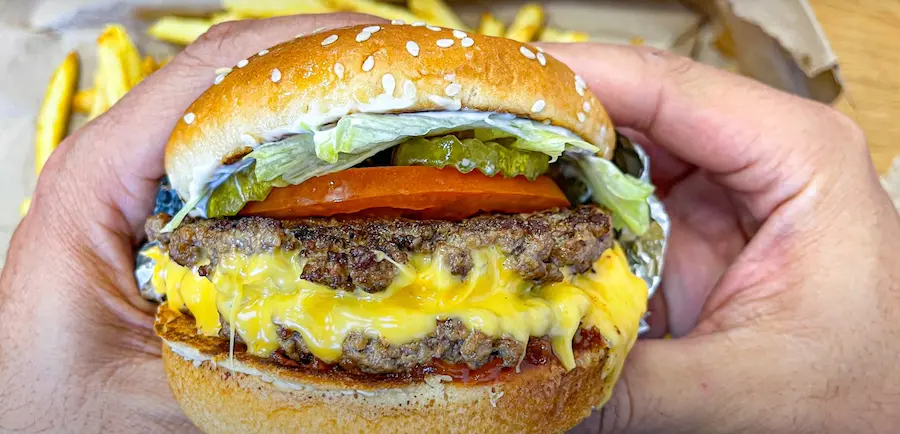
- Fried foods
- Refined grains
- Trans fats
- Whole fat dairy
- Alcohol
- Sugar-sweetened beverages
1. Fried foods
Fried foods, including fried meats, fish, vegetables, seafood, and pastries, are restricted on the OPTAVIA diet. This is because they contain unhealthy fats like saturated and trans fats, which are associated with a higher risk of health problems. A 2013 study by C. Sayon-Orea at the Department of Preventive Medicine and Public Health, University of Navarra, Spain, found that frequent consumption of fried foods was directly linked to a higher risk of developing overweight/obesity. This study involved 9,850 participants over 6.1 years.
2. Refined grains
Refined grains such as white rice, white bread, white pasta, plain white crackers, cakes, pretzels, pancakes, and rice snacks are not allowed on OPTAVIA. While research on the health impact of refined grains remains somewhat inconclusive, there are potential concerns. For instance, a 2020 study by Xiao Ning Ji and colleagues, published in the International Journal of Food Science and Nutrition, found a positive association between refined grain intake and abdominal obesity among 6913 Chinese participants.
However, other studies offer a more nuanced perspective. Glenn A. Gaesser’s work in Advances in Nutrition from 2019, involving 11 meta-analyses and data from 24 cohorts, found no association between refined grain consumption (up to 6-7 servings/day) and increased risk of chronic diseases like CHD, T2D, hypertension, or all-cause mortality.
So while refined grains seem to be ok in moderation, when it comes to building your food list on OPTAVIA, you should skip them.
3. Trans fats
Trans fats, unhealthy fats created through a process called hydrogenation, are strictly forbidden on OPTAVIA. These fats, found in margarine, shortening, non-dairy creamers, and many processed foods, are often deceptively marketed as healthier alternatives. However, studies demonstrate that trans fats are harmful, contributing to risks like coronary heart disease and cognitive decline. For instance, E. Ginter and V. Simko’s research highlights the severe health risks posed by trans-fatty acids, including their potential connection to Alzheimer’s disease.
4. Whole fat dairy
Whole-fat dairy products, like 3.25% milk, butter, heavy cream, and full-fat yogurts, are off-limits on the OPTAVIA diet plan. This might seem odd since there’s no clear proof that full-fat dairy is automatically bad for you. In fact, some studies, like one by Shelley M. Vanderhout and others, published in The American Journal of Clinical Nutrition in 2020, even suggest that kids who drink whole milk might be less likely to be overweight or obese compared to those drinking low-fat versions. Despite this, OPTAVIA sticks with strict guidelines and doesn’t allow these full-fat dairy options. They’re focusing on calorie and fat control for weight loss.
6. Sugar-sweetened beverages
Sugar-sweetened drinks and beverages such as sodas, fruit juices, lemonades, sweetened teas, sugary coffee, and various sports drinks are not allowed on OPTAVIA. These drinks contain empty calories and hinder weight loss efforts. A 2022 study by Vasanti S. Malik and Frank B. Hu from the University of Toronto and Harvard T.H. Chan School of Public Health conclusively links the habitual intake of sugar-sweetened beverages with significant health risks, including weight gain, type 2 diabetes, cardiovascular diseases, and some cancers.
On the other hand, sugar-free beverages with zero calories, such as energy drinks, teas, or coffee, are allowed on the OPTAVIA 5 and 1 program.
5. Alcohol
Drinking heavy alcohol such as vodka, whiskey, and rum is not allowed on OPTAVIA during the weight loss phase as it can hinder fat burning. But is drinking alcohol always bad on OPTAVIA? It depends. Research on this topic remains inconclusive. For example, a 2015 review by Gregory Traversy and Jean-Philippe Chaput, published in Current Obesity Reports, suggests that light-to-moderate alcohol intake might not contribute to weight gain, while heavy drinking has a stronger link to weight gain.
How To Create OPTAVIA Shopping List?
To create OPTAVIA shopping list, follow the step below.
- Educate yourself on OPTAVIA food list
- Check what you already have at home to avoid duplicate purchases.
- Match your shopping list with your meal prep day.
- Design a template categorized by food types (e.g., proteins, vegetables, snacks) to streamline your shopping process.
- Set a budget and determine how much you can afford to spend on groceries each week.
- Keep an eye out for in-store promotions, sales, and discounts that can help you save money.
- Select a store that offers a wide range of products that are on the OPTAVIA diet food list, including fresh produce, lean proteins, and healthy fats.
- Identify the least busy day and time to shop in your preferred store to have a more relaxed shopping experience.
- Work with your coach to understand which products are best suited for your health goals and dietary needs.
Studies show that shopping with a list can significantly improve eating habits and support weight management. 2015 research published in the Journal of Nutrition Education and Behavior by Tamara Dubowitz of RAND Corporation found that participants who consistently used a grocery list had a lower body mass index and higher dietary quality. At Optimal Weight Plan, our experienced team understands this, and we’ll help you create a grocery list tailored to your health goals and the OPTAVIA program.
Can an OPTAVIA Coach Tailor the Food List to my Health Goals?
Yes! Our OPTAVIA coaches partner with you to create a personalized food list that supports your individual health goals. Get the expert guidance and support you need for lasting results. Call us today on the phone number below to book your complimentary consultation and discover how an OPTAVIA coach can help you create a diet food list, build a shopping list, and navigate eating out while on the OPTAVIA plan.
What Restaurants Can You Eat at on OPTAVIA Diet?
The OPTAVIA Diet allows dining at a range of restaurants. The OPTAVIA restaurant guide includes 27 sit-down establishments like Applebee’s, Bonefish Grill, Bubba’s 33, Cheddar’s Scratch Kitchen, The Cheesecake Factory, Olive Garden, Outback Steakhouse, and Texas Roadhouse. For each menu item, the guide specifies a regular or half serving size and advises avoiding additional calorie-dense condiments like sauces and salad dressings. Glory Days Grill stands out among OPTAVIA-friendly restaurants, offering the largest selection of Lean & Green meals with six choices.
Can I Eat Fast Food while on OPTAVIA?
Yes, you can eat out at fast food restaurants while on OPTAVIA, but the options are limited. The OPTAVIA Fast Food Guide includes Au Bon Pain, Chipotle, Chick-Fil-A, Jack in the Box, KFC, Panera Bread, and Subway. Popular fast food chains like McDonald’s, Domino’s Pizza, Dunkin’ Donuts, Pizza Hut, and Papa John’s Pizza aren’t suitable for OPTAVIA cheat days. The same applies to all-you-can-eat restaurants, as they don’t offer meals that align with the Lean & Green guidelines.
What Happens if You Have a Cheat Day on OPTAVIA?
Cheat days are not allowed on the OPTAVIA program because they can slow weight loss progress. When you have a cheat day, your body stores extra calories as fat. This inhibits fat burning, hindering your journey.
While the concept of a cheat day might sound appealing, it refers to having a treat meal, a guilt-free snack, or an entire cheat meal that deviates from your diet. A recent study led by Kyle T. Ganson from the University of Toronto found that cheat meals are most common in men among adolescents and young adults, occurring with an average frequency of more than once per week. The study, published in the Journal of Eating Disorders in 2022, indicates that awareness about cheat meals and their association with potential eating disorders is important.

